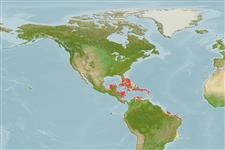>
Anguilliformes (Eels and morays) >
Chlopsidae (False morays)
Etymology: Chilorhinus: Greek, cheilos = lip + Greek, rhinos = nose (Ref. 45335).
Eponymy: Vice-Admiral Edouard Suenson (1805–1887) was a Danish naval officer who collected specimens during his voyages, including some of the type material for this species. [...] (Ref. 128868), visit book page.
More on author: Lütken.
Environment: milieu / climate zone / rango de profundidad / distribution range
Ecología
marino asociado a arrecife. Tropical
Western Atlantic: Bermuda and southern Florida, USA to Bahia in Brazil.
Tamaño / Peso / Age
Madurez: Lm ? range ? - ? cm
Max length : 18.0 cm TL macho / no sexado; (Ref. 7251)
Inhabits sandy areas and seagrass beds, usually bathed by clear, oceanic waters. Feeds on small fish and invertebrates (Ref. 42064).
Life cycle and mating behavior
Madurez | Reproducción | Puesta | Huevos | Fecundidad | Larva
They migrate en mass towards the open sea and have leptocephalus larvae.
Robins, C.R. and G.C. Ray, 1986. A field guide to Atlantic coast fishes of North America. Houghton Mifflin Company, Boston, U.S.A. 354 p. (Ref. 7251)
IUCN Red List Status (Ref. 130435: Version 2025-1)
Threat to humans
Harmless
Human uses
Pesquerías: sin interés
Herramientas
Special reports
Download XML
Fuentes de Internet
Estimates based on models
Preferred temperature (Referencia
123201): 25 - 28.1, mean 27.4 °C (based on 604 cells).
Phylogenetic diversity index (Referencia
82804): PD
50 = 0.7500 [Uniqueness, from 0.5 = low to 2.0 = high].
Bayesian length-weight: a=0.00102 (0.00046 - 0.00225), b=3.06 (2.88 - 3.24), in cm total length, based on all LWR estimates for this body shape (Ref.
93245).
Nivel trófico (Referencia
69278): 4.0 ±0.63 se; based on food items.
Fishing Vulnerability (Ref.
59153): Low vulnerability (10 of 100).
🛈
Nutrients (Ref.
124155): Calcium = 60.8 [31.0, 123.7] mg/100g; Iron = 0.54 [0.31, 1.04] mg/100g; Protein = 18.2 [15.9, 20.9] %; Omega3 = 0.155 [0.065, 0.457] g/100g; Selenium = 38.2 [17.0, 82.0] μg/100g; VitaminA = 177 [46, 657] μg/100g; Zinc = 1.4 [0.9, 2.0] mg/100g (wet weight);
